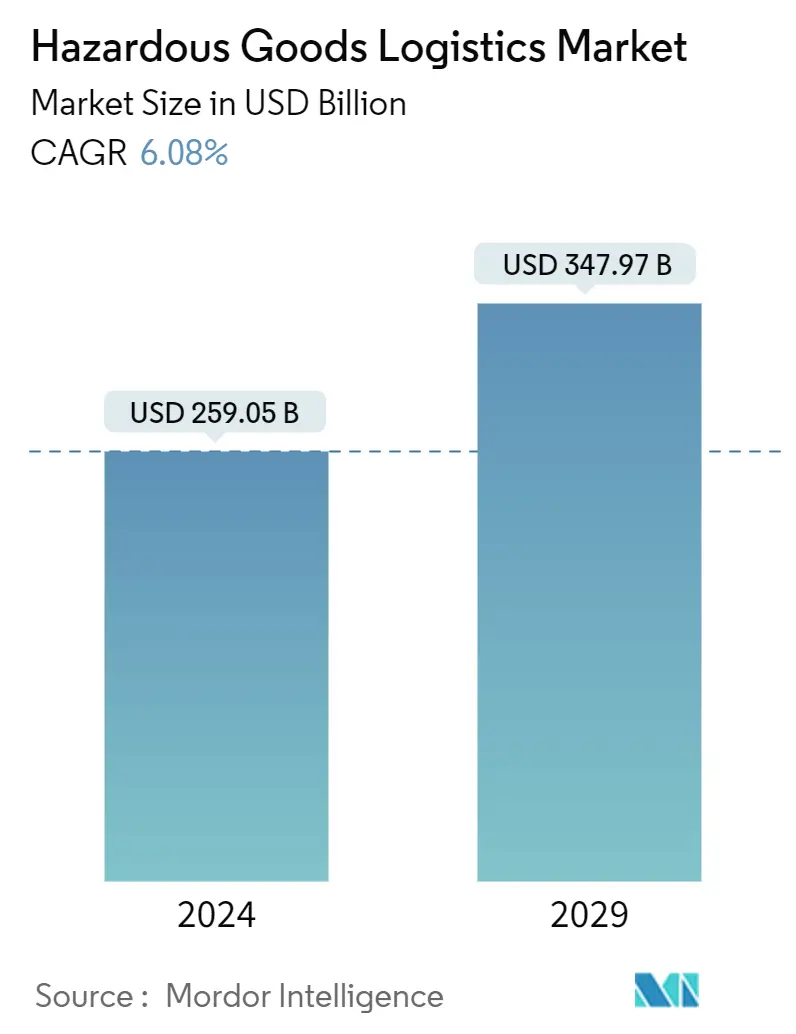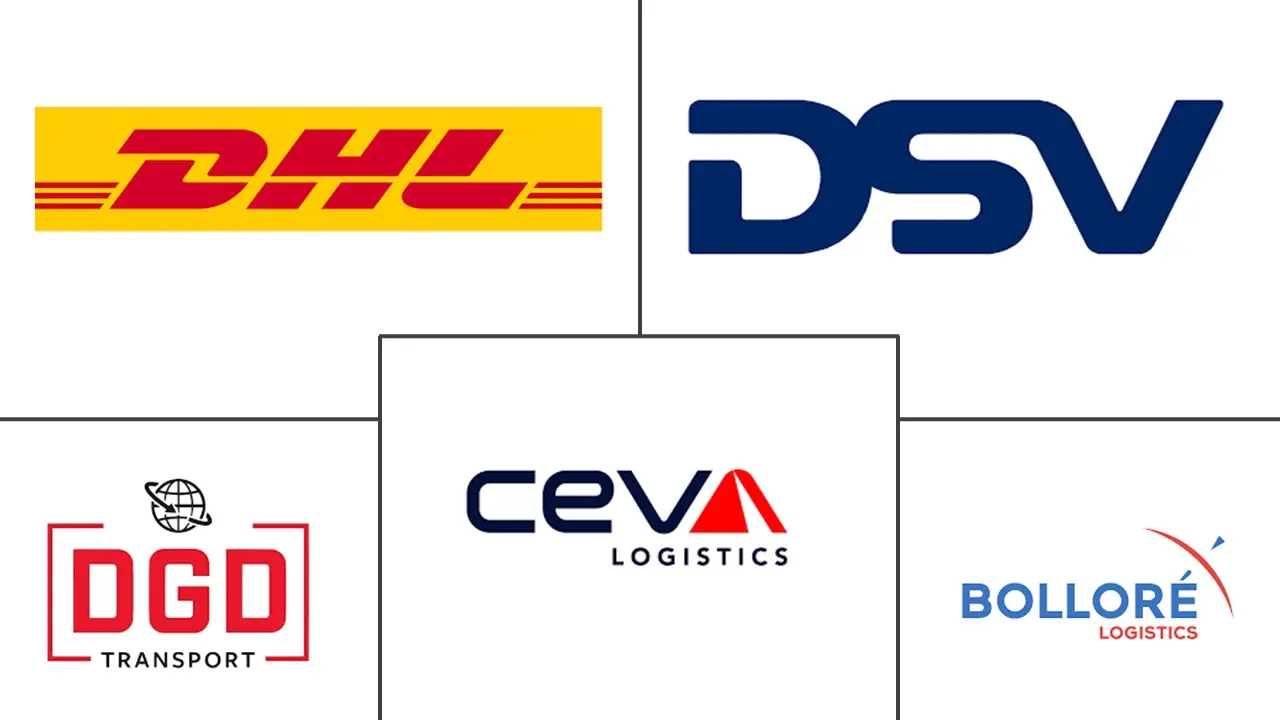Market Size of Hazardous Goods Logistics Industry

| Study Period | 2020 - 2029 |
| Market Size (2024) | USD 259.05 Billion |
| Market Size (2029) | USD 347.97 Billion |
| CAGR (2024 - 2029) | 6.08 % |
| Fastest Growing Market | Asia-Pacific |
| Largest Market | North America |
| Market Concentration | Low |
Major Players
*Disclaimer: Major Players sorted in no particular order |
Hazardous Goods Logistics Market Analysis
The Hazardous Goods Logistics Market size is estimated at USD 259.05 billion in 2024, and is expected to reach USD 347.97 billion by 2029, growing at a CAGR of 6.08% during the forecast period (2024-2029).
When shipping large quantities of hazardous materials, government agencies require accurate labeling of each product to comply with federal regulations. In 2003, the UN adopted a global system for identifying hazardous materials that may pose physical, health, and environmental risks. Dangerous materials are classified into nine hazard categories: flammable, corrosive, and gaseous. The UN number is a required four-digit number ranging from 0004 to 3548 that identifies specific dangerous goods and hazardous materials for international transportation.
Risky materials comprise the bulk of international cargo, containing many commonly used products and items. Much of this cargo reportedly consists of gasoline and other petroleum products. The current oil boom may result from unprecedented growth over the past few years due to hydraulic fracturing and a government fostering a more conducive environment for fuel production. The United States produces the bulk of the world's oil.
The requirement to ship dangerous goods is anticipated to increase yearly, in addition to the numerous hazardous goods rules being updated annually. The need for UN packaging, training, labels, and placards will rise due to the growing requirement to move lithium batteries and the region's well-established gas and oil businesses, driving the dangerous goods market to record highs.
Additionally, all forms of transportation must be used to convey radioactive medication, virus samples, healthcare hazardous chemicals, and clinical waste such as surgical equipment. For example, the oil and gas industry may impact this expected expansion of dangerous goods around the globe. The oil and gas industry, which is still lucrative, is anticipated to receive investments totaling USD 237 billion over the next 10 years, or 25% of the estimated worldwide investment in this industry.
Hazardous Goods Logistics Industry Segmentation
Corrosive, flammable, explosive, spontaneously combustible, poisonous, oxidizing, or water-reactive compounds are hazardous. Logistics refers to managing how resources are acquired, stored, and transported to the final destination. A complete background analysis of the hazardous goods logistics market, including the assessment of the economy and contribution of sectors in the economy, market overview, market size estimation for key segments, and emerging trends in the market segments, market dynamics, and geographical trends, and the COVID-19 impact, is covered in the report.
The hazardous goods logistics market is segmented by service (transportation, warehousing and distribution, and value-added services), destination (domestic and international), and geography (Asia-Pacific, North America, Europe, Latin America, and Middle East and Africa). The report offers market size and forecasts for all the above segments in value (USD).
| By Service | |
| Transportation | |
| Warehousing and Distribution | |
| Value-added Services |
| By Destination | |
| Domestic | |
| International |
| By Geography | |
| Asia-Pacific | |
| North America | |
| Europe | |
| Latin America | |
| Middle East and Africa |
Hazardous Goods Logistics Market Size Summary
The hazardous goods logistics market is poised for significant growth, driven by the increasing need to transport risky materials, which constitute a substantial portion of international cargo. This demand is largely fueled by the oil and gas industry, particularly in the United States, which leads global oil production. The market is also influenced by the rising transportation of lithium batteries and the ongoing expansion of gas and oil businesses. The deregulation of environmental policies has further bolstered the oil and gas sector, contributing to the market's expansion. Additionally, the logistics of hazardous goods encompass various sectors, including pharmaceuticals, nuclear power, and petrochemicals, necessitating stringent adherence to safety regulations and standards.
The market landscape is characterized by a mix of global and local players, with companies like DHL, DSV, Ceva Logistics, and Bollore Logistics leading the charge. These firms are leveraging technology and strategic partnerships to enhance their service offerings and meet the growing demands of hazardous goods transportation. The integration of digital supply networks is transforming logistics operations, facilitating better coordination among suppliers, customers, and logistics providers. Despite challenges posed by the COVID-19 pandemic, the market is expected to benefit from stricter government regulations and advancements in logistics technology, such as BlackBerry's asset tracking solutions and Drone Delivery Canada's drone delivery capabilities. These developments are set to enhance the safety and efficiency of transporting hazardous materials across various modes of transport.
Hazardous Goods Logistics Market Size - Table of Contents
-
1. MARKET INSIGHTS AND DYNAMICS
-
1.1 Current Market Scenario
-
1.2 Industry Value Chain Analysis
-
1.3 Government Regulations and Initiatives
-
1.4 Brief on Dangerous Goods Classes
-
1.5 Review and Commentary on Goods Transport Regulations and Standards (Hazardous Materials Transportation Act (HMTA), International Air Transport Association Dangerous Goods Regulations (IATA DGR), etc.)
-
1.6 Focus on Key Stakeholders in Supply Chain (Freight Forwarders, Ground Handling Agents, Carriers, Advisors and Consultants, etc.)
-
1.7 Key Information - Documentation, Special Permissions, and Safety Checklists
-
1.8 Spotlight - Equipment and Accessories Associated with Transport of Dangerous Goods (Air, Sea, and Road)
-
1.9 Potential Risk Involved in Shipment of Hazardous Materials
-
1.10 Insights on Packaging
-
1.11 Technology Snapshot (Digitalization and Process Optimization and Management Software, e-Dangerous Goods Declaration (eDGD), etc.)*
-
1.12 Impact of COVID-19 on the Market
-
1.13 Market Dynamics
-
1.13.1 Market Drivers
-
1.13.1.1 The growth of international trade has led to an increased demand for the transportation of hazardous materials
-
1.13.1.2 Growing environmental awareness has led to an increased focus on eco-friendly and sustainable logistics practices.
-
-
1.13.2 Market Restraints/Challenges
-
1.13.2.1 Ensuring compliance with these regulations is a constant challenge for logistics companies.
-
1.13.2.2 Maintaining the security of shipments and facilities is a significant challenge, requiring surveillance, access controls, and other security measures.
-
-
1.13.3 Market Opportunities
-
1.13.3.1 With strict regulations governing the transportation of hazardous materials, there is a growing demand for companies that specialize in ensuring compliance.
-
-
-
1.14 Industry Attractiveness - Porter's Five Forces Analysis
-
1.14.1 Bargaining Power of Suppliers
-
1.14.2 Bargaining Power of Buyers/Consumers
-
1.14.3 Threat of New Entrants
-
1.14.4 Threat of Substitute Products
-
1.14.5 Intensity of Competitive Rivalry
-
-
-
2. MARKET SEGMENTATION
-
2.1 By Service
-
2.1.1 Transportation
-
2.1.2 Warehousing and Distribution
-
2.1.3 Value-added Services
-
-
2.2 By Destination
-
2.2.1 Domestic
-
2.2.2 International
-
-
2.3 By Geography
-
2.3.1 Asia-Pacific
-
2.3.2 North America
-
2.3.3 Europe
-
2.3.4 Latin America
-
2.3.5 Middle East and Africa
-
-
Hazardous Goods Logistics Market Size FAQs
How big is the Hazardous Goods Logistics Market?
The Hazardous Goods Logistics Market size is expected to reach USD 259.05 billion in 2024 and grow at a CAGR of 6.08% to reach USD 347.97 billion by 2029.
What is the current Hazardous Goods Logistics Market size?
In 2024, the Hazardous Goods Logistics Market size is expected to reach USD 259.05 billion.

